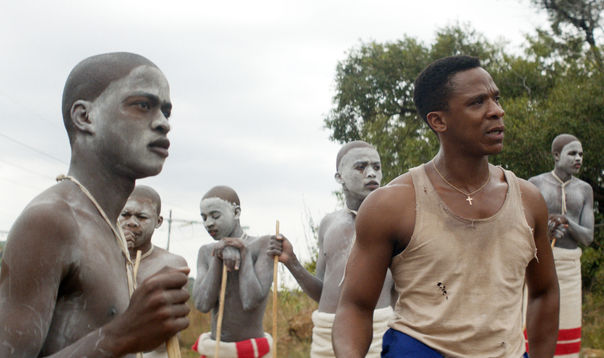Culture Will Not Be Circumcised
By Adefoyeke Ajao

Film still from THE WOUND © Urucu Media
Two snips is all it takes to make a man within traditional Xhosa culture, if the male circumcision rites featured in John Trengove’s THE WOUND (Berlinale Panorama) are taken literally. However, it soon becomes clear that it will take more than a razor to cut into the core of society. Set in South Africa, against the backdrop of a circumcision camp, the film explores the tensions between age-long customs and contemporary inclinations through the sexual preferences of two childhood friends and “caregivers”, Xolani (Nakhane Touré) and Vija (Bongile Mantsai), and a bourgeois teenager named Kwanda (Niza Jay Ncoyini), who has been coerced into partaking in the circumcision ritual by his father.
Traditional society’s selective assimilation of what it considers to be foreign is evident. While kids are fascinated with cable TV, swimming pools and smart phones, they are resolute in their intolerance for homosexuality – obvious, when one of the initiates confronts Xolani with rumours about his sexuality.
The identity crisis that accompanies the denial of sexuality is palpable throughout the film’s runtime. Xolani’s deadpan expression hides the dissonance between his cultural beliefs and his natural desires. Vija (who ironically is a married father of three girls), masks his turmoil behind a veneer of exaggerated masculinity. Unable to openly express their feelings for each other, both men seek solace in sharing drinks, cigarettes, and secret sexual encounters in the forest. That is a riveting watch as both actors convincingly pull off the roles of tormented lovers through vivid and steamy sex scenes. Kwanda seems to be the only one willing to stand up for his beliefs although he is brash in his approach to challenging traditions and his obsession and frequent intrusions into Vija and Xolani’s romance belie common sense. THE WOUND is laced with cultural allusions: the dialogue is mostly in the local language and is interspersed with dance, song and rituals. In addition, the detailed subtitles give a delightfully clear understanding into the workings of the Xhosa rite of passage. These references also serve as a contrasting canvass on which the characters’ stick out like a sore thumb against a macho culture.
Through its characters, Trengove’s film magnifies the displacement of LGBT within a pre-existing culture. It reveals the turmoil of being an outcast within a traditional space.

